Last Updated on January 18, 2024 by Greg Gillson
Winter is a wonderful time to feed birds in Virginia. This state boasts many birds that come to bird feeders.
This article tells why and how to set up a bird feeder in Virginia in the winter. I’ll also show you photos of the common feeder birds in Virginia that you can look for at your own backyard feeder! I will give brief identification tips. I will tell you what foods and what type of feeders attract each species.
Winter weather in Virginia is described as frigid. The coldest month is January. Snowfall happens December through March. Up to 8 inches per year of snow falls along the coast. Inland mountains receive about 25 inches of snow a year, but up to 100 inches in the Appalachians.
All that snow means that birds will be looking for food at your feeders!
 |
| Image by GeorgiaLens from Pixabay |
Why feed winter birds in Virginia
Many winter feeder birds in Virginia are year-round residents. These include cardinals, chickadees, jays, woodpeckers, and house finches.
But these are supplemented in winter with visitors from the north and from the mountains. Common among these are White-throated Sparrows and Dark-eyed Juncos.
Winter birds at feeders will include many birds in their first year. They’ve never gone through winter before. So they may be inexperienced in finding natural foods. They will readily flock to your feeders!
Set up your bird feeders in late fall so that birds moving around then find your feeders. When the harsh weather arrives, they will be established at your feeders and remain in place all winter.
As important as food, having a source of fresh unfrozen water is important for birds in winter. If you live in an area of the state with multiple days of freezing weather, then consider setting up a bird bath with heater.
Watching birds at your feeder in winter is a source of endless joy. Why not give bird feeding a try this coming winter?
What birds come to feeders in winter in Virginia?
As already mentioned, jays, chickadees, nuthatches, and other resident birds come to feeders year-round. But they may visit more regularly in winter.
Woodpeckers may be in your backyard all year. But they may come to your feeders more often in winter.
Sparrows and finches love your seed feeders. Many of these birds are migratory. They move out of more northern or mountainous areas to winter in Virginia.
There are many additional birds in Virginia that commonly visit your backyard. But these do not generally eat at feeders. Please read my article on the most common backyard birds of Virginia. This article identifies the common birds in your backyard all through the year, whether or not they come to feeders. I’ll link to it again at the end of this article, so you can read it next, if you want.
Here are the common winter feeder birds in Virginia. Each species account gives simple identification pointers, and what foods at your feeder will attract them best.
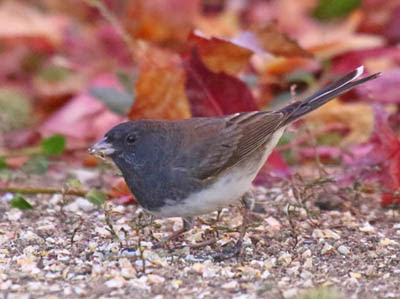 |
| Dark-eyed Junco Photo by Greg Gillson |
Dark-eyed Junco
These tiny little sparrows are often the first sign that winter is on the way. Juncos often form large flocks in your neighborhood, foraging under your feeders.
They hop on the ground, scratching in the dirt for food under bushes and small conifer trees.
Dark-eyed Juncos breed across the boreal forest of Canada and Alaska. They breed in conifer mountain forests in both the West and East.
In winter juncos move southward to be found across southern Canada, all of the United States, and even across northern Mexico.
In Virginia, Dark-eyed Juncos breed in the highest mountains in the west part of the state. They winter throughout Virginia.
These are very small plump sparrows with a large-looking head. The squared black tails stick out behind constantly flicking open to reveal white tail feather edges. They have conical seed eating bills, but rather dainty and pointed, colored pink. The legs and feet are also pink.
There are several different populations across North America, each a bit different in coloration. Birds in Virginia are of the Slate-colored Junco variety. Males are slate blackish-gray throughout, with an extensive white belly. Females are often paler with a brownish wash on the back.
They give smack calls and tick sounds in winter.
Juncos feed on platform feeders or trays on hopper feeders. But they really prefer to feed on the ground under the feeders where seeds fall. They will eat hulled sunflower seeds, black oil sunflowers, and are especially attracted to white proso millet.
 |
| Image by tlparadis from Pixabay |
Northern Cardinal
These bright red birds are the most frequently seen winter birds at feeders in Virginia. They aren’t the most numerous, but it seems there is often a pair in every yard or every feeder.
Though bright and colorful, these birds tend to be rather shy. You may see them hopping in the lawn, or hiding away in brushy tangles.
Northern Cardinals are common birds in the Eastern, Southeastern, and Southwest. They live in woodlands and gardens all year long.
In Virginia, cardinals are year-round residents.
Cardinals are fairly large chunky sparrow-like birds related to the Scarlet Tanager and Rose-breasted Grosbeak. They have a very large thick bill for eating seeds. The tail is full and rounded. The full crest is an obvious mark on both males and females.
Males are all-over red with black on the face. Females are a duller tan with reddish hints.
Birds sing nearly all year. The song includes repeated whistled phrases such as birdy-birdy-birdy or cheer-cheer-cheer. The common call note is a sharp chip!
Northern Cardinals love to eat sunflowers and larger seeds such as safflower seeds. They prefer platform feeders and hopper feeders with larger trays.
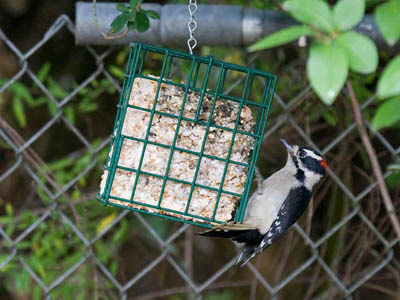 |
| Downy Woodpecker Photo by Greg Gillson |
Downy Woodpecker
Most people love to have woodpeckers visit their bird feeders. None is more welcome than the cute little Downy Woodpecker.
Like most woodpeckers, Downys climb tree trunks, pecking in the bark for food. These small birds also cling to small branches and even heavy weed stalks. They follow winter flocks of chickadees, kinglets, and nuthatches.
Downy Woodpeckers live year-round in deciduous woods, especially near water. They are equally at home in backyards, parks, and gardens. They are found across Alaska, Canada, and most of the United States except for the southwestern deserts.
Downy Woodpeckers live year-round throughout Virginia.
These are small stocky birds, barely over 6 inches long, bill tip to tail tip. The bill is short and pointed, but not strong and as chisel-like as other woodpeckers. The tail is short, stiff, and pointed. The legs are short, but the feet are large and strong.
The bird is white on the underparts and black above with white spots on the wings. The back is white. The head is striped black-and-white. Males have a little red spot on the back of the crown.
The common call is a sharp pick! note. In spring these are combined into a rattling whinny.
Downy Woodpeckers are attracted primarily to your suet feeder (as in photo above), though they will eat sunflower seeds from hopper and platform feeders.
 |
| Tufted Titmouse Image by Anne773 from Pixabay |
Tufted Titmouse
If you have a wooded backyard in the East, then this cheerful little bird likely lives there.
They are vocal and rather tame. They hop and crawl through trees and bushes. They search bark and twigs for insects and seeds.
Tufted Titmouses are year-round residents in deciduous woods. They are found in the eastern half of the United States, west to Texas, Minnesota.
In Virginia, the Tufted Titmouse lives year-round, mostly below 2000 feet elevation.
Titmouses are similar to the related chickadees, though a bit larger. They are stocky with a full tail and large crested head. They have strong legs and feet.
These birds are colored gray throughout, with black on the forehead and a peachy wash on the flanks.
Tufted Titmouses sing throughout the year, a Peter-Peter-Peter whistle. They also give chickadee-like call notes.
At your hopper feeder these birds love black oil sunflower seeds and pieces of peanuts. They will also eat suet–especially with peanuts or peanut butter.
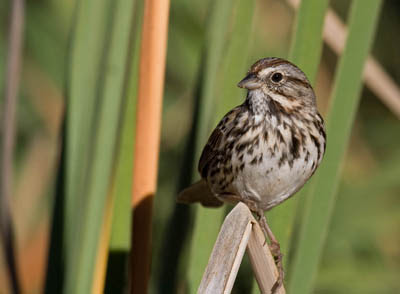 |
| Song Sparrow Photo by Greg Gillson |
Song Sparrow
These little brown streaked sparrows are one of the most widespread in North America.
Song Sparrows hop and feed on the ground, remaining close to low bushes for cover and escape.
These birds are found in marshes, river edges, brambles, and large landscaping bushes.
They breed from southern Alaska south to northwestern Mexico, across Canada and the northern United States. In winter, birds from the north migrate south to the entire U.S., but many remain year-round at mid-latitudes.
Song Sparrows breed in the mountains of northern and western Virginia. In winter they are found throughout the state.
This is a plump sparrow with a rounded tail tip. The bill is thick and cone-shaped for eating seeds.
The upper parts are gray, streaked with both light rusty and dark brown. The head is gray with rusty brown lateral crown stripes, a stripe back from the eye, a thin mustache stripe, and a wide lateral throat stripe. The throat is white. The breast is white and heavily spotted, especially on the center of the breast, where many spots merge into one patch.
Song Sparrows are frequent singers, often even on sunny days in winter. A common call note sounds like chimp!
These birds are rather wary around the feeders and other feeding birds. They may sneak to your hopper or platform feeder when there are no other birds present. More often, you may notice them on the ground under the feeders or under a nearby bush. They eat black oil sunflower seeds and smaller millet seeds at your feeder.
 |
| Carolina Chickadee Image by GeorgeB2 from Pixabay |
Carolina Chickadee
This is the common friendly little chickadee of the Southeast.
Flocks move through the trees. They cling and hang from the tips of branches looking for insects. But they readily eat seeds at your bird feeder, too, where they are fearless. In fact, they may trustingly take sunflower seeds from your hand!
Carolina Chickadees are found in deciduous woods and residential areas.
These birds are resident from New Jersey to southern Illinois and south from central Texas to northern Florida.
Carolina Chickadees are year-round residents throughout Virginia.
Like other chickadees, these little balls of fluff are plump with a big head and fairly long active tail. They have strong legs and feet. The bill is short, but blunt. They are smaller than Black-capped Chickadees.
In typical chickadee pattern they are gray above and white below. The black cap and throat contrast with the white hind face. There is a faint buff wash on the flanks.
The flanks aren’t as richly-colored, and the wings lack the strong white feather edges of the more northly Black-capped Chickadees. Otherwise they are very similar except for the voice.
And, speaking of the voice, Carolina Chickadees give a higher, faster chick-a-dee-dee-dee call than Black-cappeds.
Carolina Chickadees love black oil sunflower seeds from any kind of feeder. They come in and grab a single seed and then fly away to hide it for later. When they eat a seed, they hold it in their feet on a limb and pound the seed open with their bill. They also love suet.
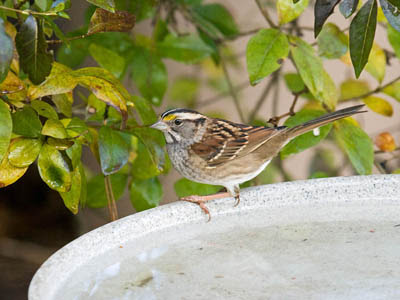 |
| White-throated Sparrow Photo by Greg Gillson |
White-throated Sparrow
This sparrow is a winter visitor at feeders in much of the East and Southeast, quite rare in the West. It is similar to the White-crowned Sparrow that winters in the southern half of the United States and West Coast.
They hang out in brushy patches with scrubby trees. They scratch around on the ground, but also visit feeders. When startled, they are more likely to into a small tree, rather down in the brambles as other sparrows.
They generally nest in woodlands across Canada and the northernmost of the eastern states. They winter from the Northeast to Illinois and to southern Arizona. And then they winter southward from here from Texas to Florida.
White-throated Sparrows winter throughout Virginia.
These are rather large sparrows with long tails. The bill is conical for eating seeds.
They are light brownish above with dark brown stripes on the back. The chest is gray, contrasting with the white throat. The head is striped with either black-and-white or brown-and-tan. There is a yellow spot of feathers right in front of the eyes. The bill is gray. The legs and feet are pink. There are two thin white wing bars.
The call note is a very loud metallic pink! This is often given at dawn and dusk.
White-throated Sparrows eat sunflower and other smaller seeds. They prefer eating on the ground, so look for them on platform feeders or hopper feeders with a wide shelf.
 |
| Mourning Dove Photo by Greg Gillson |
Mourning Dove
This rather tame dove may build its stick nest on your porch in summer. If your winters aren’t too severe, they may remain in your yard.
Look for this dove on telephone lines, fence lines, and the tips of small trees. They may even soak up the sun’s rays on the peak of your roof! They look for food on the ground where they walk and bob their heads.
Mourning Doves live in a wide variety of habitats, including open country, river side trees, farms, and residential yards.
They breed from southern Canada southward across most of the United States and Mexico. In winter, these doves migrate out of Canada and out of the north Plains states. Otherwise, they are resident across most of the US.
Mourning Doves are resident year-round throughout Virginia.
These doves have the plump body of other doves. But the long pointed tail makes the bird look slim sometimes. The neck is long and the round head is small. The legs are short. The bills of doves are rather short, thin, and bluntly pointed.
Mourning Doves are tan below, slightly darker on the back and wings. It has large black spots on the wing. The long pointed tail has white edges. The feet are pink.
In spring you may be familiar with the sad cooing song of this dove. These birds are quiet in winter, except for the whistling of their wings as they fly.
Mourning Doves eat grain and seeds, so they like some of the cheapest mixed bird seeds with grains and corn that other birds don’t like. They also eat black oil sunflower seeds. While they may prefer to eat on the ground or on a platform feeder, some birds squeeze themselves onto even small hopper feeders!
 |
| House Finch Photo by Greg Gillson |
House Finch
Along with House Sparrows, these House Finches are likely to be one of the most common “little brown birds” at your feeder, summer or winter.
Family groups or small flocks visit your yard. When startled they usually fly up noisily into the tips of nearby smaller trees.
In the East, House Finches are found primarily in residential areas. in the West they were originally found in dry canyonlands, but are now abundant in residential areas and farmlands.
These finches are resident across extreme southern Canada, most of Mexico, and all of the United States except for high mountains and southern Florida.
House Finches are year-round residents throughout Virginia.
Rather compact birds, they have a larger head and medium tail with slight notch in the tip. The bill is thick and conical, curved on the upper ridge.
Both genders are rather gray with dark brown streaks above. The pale, almost white under parts are heavily streaked with blurry brown. Males have red-orange forehead, upper breast, and rump.
Winter flocks chirp, the note sounding like wheet.
House Finches love black oil sunflower seeds from tube feeders or hopper feeders.
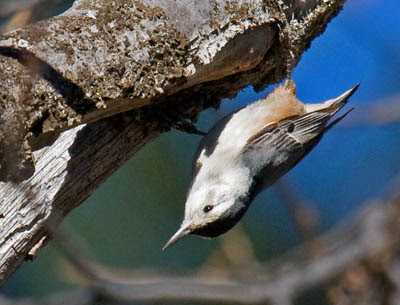 |
| White-breasted Nuthatch Greg Gillson |
White-breasted Nuthatch
What’s that bird crawling upside down on the tree trunk? It’s a nuthatch! There are four kinds in North America. This is the largest of the four nuthatch species (though still small).
Nuthatches crawl over, under, and around tree branches and trunks. They find insects in the bark from their unusual perspective.
These nuthatches are the only ones generally found in deciduous trees. In the West they favor oaks, but also pines.
They are year-round residents in most of the places they occur. They are found from southern Canada (further northward in the West) southward to the northern parts of the Gulf States. In the West they are found into the highlands of Mexico, but absent from the sage, scrub, and cacti deserts. In the Great Plains they occur along water courses with trees. But, of course, they are absent from grasslands.
White-breasted Nuthatches are year-round residents throughout Virginia.
Nuthatches are short, plump birds. The have a large head on a short neck. The tail is straight and stubby. Legs and feet are large and strong. The bill is long and chisel-shaped.
White-breasted Nuthatches are blue-gray above and white below. They have a black crown that contrasts with the white face with a black beady eye in the center. Some birds have a touch of rust on the vent area.
The call of this species is a nasal yank.
White-breasted Nuthatches love black oil sunflower seeds. They take one at a time from your hopper feeder, then fly off. They may eat the seed, holding it in their feet against a branch and pounding it open. It is just as likely, though, that they cache a pile of seeds away to eat later in the year.
 |
| American Goldfinch Photo by Greg Gillson |
American Goldfinch
The bright yellow and black males in summer are a favorite of bird watchers throughout North America. In winter, though, the plumage is subdued. You may not recognize them.
Goldfinches are often found in flocks. They are tiny birds.
These birds live wherever they can find fields of small weed and thistle seeds. They like open woodlands and road edges.
In summer, American Goldfinches breed from southern Canada to the middle latitudes of the United States, to northern Georgia and Alabama, Oklahoma, northern Utah, and all the way to coastal southern California.
In winter, American Goldfinches leave Canada almost completely. They move southward to all of the U.S. and into northeastern Mexico.
American Goldfinches breed in summer in the western two-thirds of Virginia. They winter throughout the whole state.
These are very small birds with round heads. The small bill is conical, but pointed. The under tail coverts are very long, making the forked tail look very short.
In winter, American Goldfinches lack the bright lemon yellow summer plumage with jet black wings and tails. Birds are pale tan or brown above. They are white below–especially on the under tail covert feathers, with buttery yellow throats. White wing bars are obvious on the dark wings.
Calls are soft and whiney. Flying they give a rapid whistled per-chik-o-ree call.
American Goldfinches are especially attracted to thistle feeders where they eat Niger seed (as in the photo above). They also eat black oil sunflower seeds from tube feeders.
 |
| Red-bellied Woodpecker Image by skeeze from Pixabay |
Red-bellied Woodpecker
Red-bellied Woodpeckers are fairly large common backyard birds in the East.
Woodpeckers cling to the trunk of trees with their large, strong feet. Their very long tongue pulls out insects from deep within the bark.
These birds live in deciduous forests, especially near water. They also like shade trees in residential areas.
These birds live year-round in the East, south of the New England States, westward to Nebraska and eastern Texas.
Red-bellied Woodpeckers live year-round throughout Virginia.
These birds have the typical woodpecker build. They are fairly stocky with a short neck and large head. They have a short pointed tail. The bill is long and chisel-shaped.
The body and head of these birds is pale gray. The back and wings are barred with many thin black-and-white feathers. Birds have a red crown, more extensive (bill to back) on the males.
The calls of Red-bellied Woodpeckers is a loud rolling churrr.
At your feeder they love peanuts or other nuts offered on a platform feeder. They may eat sunflower seeds. They also like suet.
 |
| Blue Jay Image by skeeze from Pixabay |
Blue Jay
This is a fairly bold bird of backyards in the East and Central parts of the United States.
Blue Jays are striking, active, and colorful. But they are a little too boisterous for many of the smaller feeder birds–and with a big appetite for feeder seeds!
These birds live in deciduous and mixed woods, especially oaks. They like larger trees in residential areas.
These jays are found east of the Rocky Mountains from Canada south to Florida. In winter they travel around a bit, moving into the northwestern parts of the US and adjacent Canada. They also move westward into western Texas and New Mexico.
Blue Jays live year-round throughout Virginia.
Jays have large heads and long full rounded tails. They have strong black legs and feet. The bill is black, long, stout, and pointed. This species has a crest.
These birds are blue above and light gray below, fading to white on the lower belly. The face is white, bordered by a thin black necklace below, and blue crown and crest above. The wings and tail are blue with black bars and some white spots. In flight, Blue Jays flash white wing patches and white tail corners.
The common call of Blue Jays is a loud rough jeer.
They love peanuts and other nuts. They love suet, too. They will gulp down a gullet full of sunflower seeds and take them away to bury them to eat later in the season, a behavior called caching. They will soon empty your feeders in fall. They are heavy, so like eating from larger platform or hopper feeders with large trays.
Feeding black oil sunflower seeds in tube feeders will keep the sunflower seeds away from the jays and allow the finches and chickadees to get some.

Setting up a winter bird feeding station in Virginia
There are so many birds that come to feeders in Virginia that I recommend setting up several different kinds to attract the widest variety!
I rarely recommend platform feeders. However, the juncos, cardinals, doves, jays, and sparrows will all like that type of feeder best. Get one with an ample roof to keep out the rain and snow. Feed mixed bird seed. Add peanuts or other nuts to attract woodpeckers.
The best mixed bird seed I’ve found is Wagner’s Songbird Supreme. It has no filler like wheat, corn, or milo; it is 50% sunflower seeds–I highly recommend it!
Then set up a tube feeder with black oil sunflower seeds. This will attract both the red and yellow finches, chickadees, titmouses, and nuthatches.
I really like the Nature’s Way upside-down suet feeder. It keeps out the always gluttonous jays and starlings. The chickadees really benefit.
A suet feeder will provide much needed protein and fat during the cold season. It will attract woodpeckers, especially if it has peanuts in it.
I’ve been purchasing St. Albans Bay suet cakes. Half are peanut, half are berry. And it is less expensive than many brands. The birds love it!
Birds need water to drink and keep their feathers in good condition. This is especially important in winter when the natural water supply may be frozen for days at a time. So consider adding a bird bath and perhaps a bird bath heater to your yard.
Wrapping Up
Virginia offers a surprisingly diverse array of bird life even during the winter months! While many species migrate south for warmer climates, there are plenty of feathered friends who brave the colder temperatures and stick around the state year-round, and others who visit from the north to escape even harsher conditions. Here are some of the birds you can expect to see in Virginia during winter:
Dark-eyed Juncos: These gray birds with white bellies flock to Virginia from the north, seeking seeds and sheltered areas.
Snow Geese: These large white geese with black wingtips visit in massive flocks, often seen near water bodies and fields.
Canada Geese: These familiar honking geese are common winter residents, found near lakes, ponds, and rivers.
Bald Eagles: These majestic birds of prey are an impressive sight, soaring over Virginia’s waterways and occasionally seen hunting for fish.
Red-tailed Hawks: These large hawks with their striking red tails are skilled predators, often perched on trees or soaring over fields.
Frequently Asked Questions
Do Cardinals stay in Virginia for winter?
Northern Cardinals are one of the most prominent year-round residents in Virginia and throughout most of their extensive range. They don’t migrate south for warmer climates like many other songbirds but cheerfully stick around to brighten the winter landscape with their vibrant colors and melodic songs.
Several factors contribute to their decision to stay put:
Adaptability: They’re resourceful birds, adept at finding food sources like seeds and berries even in colder temperatures. Their strong beaks help them crack open tough seeds, and they readily utilize feeders provided by humans.
Habitat availability: Virginia offers diverse habitats like woodlands, shrublands, and even backyards with ample vegetation, providing Cardinals with suitable shelter and nesting sites throughout the year.
Tolerant of cold: Their thick plumage and efficient metabolism help them regulate body temperature and cope with winter chills.
In fact, you might even see larger flocks of Cardinals during the winter months. Birds from more northern regions sometimes venture south in search of better food availability, and Virginia can be a welcoming destination for them. So, whether you’re an avid birdwatcher or simply enjoy the presence of feathered friends, you can count on your local Northern Cardinals to stay cozy and bring a touch of cheer to the Virginia winter.
Where can I go birding in Virginia in winter?
Virginia is a birdwatching paradise year-round, but winter offers a unique opportunity to see resident birds, winter visitors, and even some unexpected migrants seeking milder temperatures further north. Here are some fantastic birding spots in Virginia to explore during the winter months:
Coastal Highlights:
Eastern Shore of Virginia National Wildlife Refuge: Home to Bald Eagles, Snow Geese, waterfowl, and shorebirds.
Kiptopeke State Park: A popular location for wintering raptors like hawks and owls, along with migrating songbirds.
False Cape State Park: Offers varied habitats for waterfowl, shorebirds, and wintering sparrows.
Back Bay National Wildlife Refuge: Great for waterfowl observation, including ducks, geese, and swans.
Jamestown Island and Colonial National Historical Park: Explore historic sites while keeping an eye out for Bald Eagles, Osprey, and wintering songbirds.
Urban Birding:
Riverbend Park in Potomac Falls: Excellent for winter waterfowl and bald eagles along the Potomac River.
Huntley Meadows Park in Alexandria: Diverse habitats attract numerous winter residents and migrants.
Newport News Park: Great for winter waterfowl, herons, and shorebirds near the James River.
Backyards and local parks: Don’t underestimate the potential of your own backyard or nearby park, especially with bird feeders offering food and attracting various wintering species.
How can I help little birds in my backyard in the winter?
Helping little birds in your backyard during the winter months is a wonderful way to show compassion and make a positive impact on their lives. Here are some things you can do:
Provide Food:
Different birds have different preferences. Provide a mix of sunflower seeds, nyjer seeds, millet, and cracked corn to attract a wider range of feathered friends.
Make sure feeders are in sheltered locations, protected from wind and rain. Consider using squirrel-proof feeders to keep these furry bandits at bay.
Suet provides high-fat content for hungry birds, while fruits like grapes and berries offer an alternative source of energy and nutrients. Regularly clean your feeders with soapy water to avoid the spread of diseases and ensure a constant supply of food for the birds.
Offer Water:
This is crucial during freezing temperatures, as a reliable source of fresh water is essential for birds’ survival. Keep the birdbath clean and free of ice to prevent the spread of bacteria and ensure hygienic access for the birds.
Create Shelter:
These provide valuable cover and protection from harsh weather and predators. A loose pile of branches and leaves creates a cozy haven for birds to roost and escape the elements. Lastly, if you’re looking for a long-term project, consider installing nesting boxes specifically designed for small birds.
Related Articles:
The most common backyard birds in Virginia
My recommended bird feeder setup










